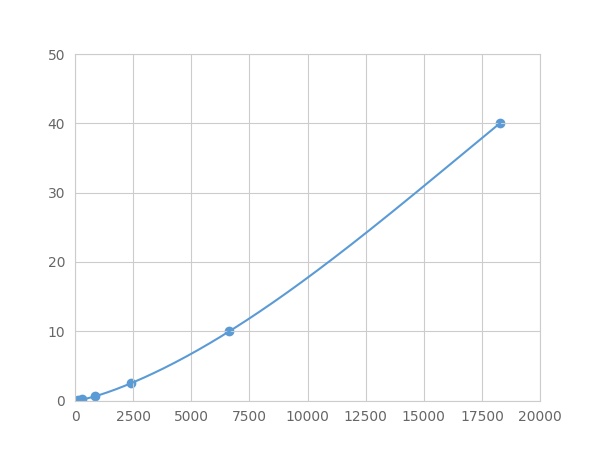Packages (Simulation)

Reagent Preparation

Image (I)
Image (II)
Certificate


Multiplex Assay Kit for Synaptophysin (SYP) ,etc. by FLIA (Flow Luminescence Immunoassay)
Major synaptic vesicle protein p38
(Note: Up to 8-plex in one testing reaction)
- Product No.LMA425Mu
- Organism SpeciesMus musculus (Mouse) Same name, Different species.
- Sample TypeSerum, plasma, tissue homogenates, cerebrospinal fluid and other biological fluids
- Test MethodDouble-antibody Sandwich
- Assay Length3.5h
- Detection Range0.04-40ng/mL
- SensitivityThe minimum detectable dose of this kit is typically less than 0.013 ng/mL.
- DownloadInstruction Manual
- UOM 8Plex 7Plex 6Plex 5Plex 4Plex 3Plex 2Plex1Plex
- FOB
US$ 518
US$ 538
US$ 568
US$ 608
US$ 647
US$ 707
US$ 797
US$ 996
Add to Price Calculator
Result
For more details, please contact local distributors!
Specificity
This assay has high sensitivity and excellent specificity for detection of Synaptophysin (SYP) ,etc. by FLIA (Flow Luminescence Immunoassay).
No significant cross-reactivity or interference between Synaptophysin (SYP) ,etc. by FLIA (Flow Luminescence Immunoassay) and analogues was observed.
Recovery
Matrices listed below were spiked with certain level of recombinant Synaptophysin (SYP) ,etc. by FLIA (Flow Luminescence Immunoassay) and the recovery rates were calculated by comparing the measured value to the expected amount of Synaptophysin (SYP) ,etc. by FLIA (Flow Luminescence Immunoassay) in samples.
| Matrix | Recovery range (%) | Average(%) |
| serum(n=5) | 78-103 | 97 |
| EDTA plasma(n=5) | 98-105 | 102 |
| heparin plasma(n=5) | 89-98 | 95 |
Precision
Intra-assay Precision (Precision within an assay): 3 samples with low, middle and high level Synaptophysin (SYP) ,etc. by FLIA (Flow Luminescence Immunoassay) were tested 20 times on one plate, respectively.
Inter-assay Precision (Precision between assays): 3 samples with low, middle and high level Synaptophysin (SYP) ,etc. by FLIA (Flow Luminescence Immunoassay) were tested on 3 different plates, 8 replicates in each plate.
CV(%) = SD/meanX100
Intra-Assay: CV<10%
Inter-Assay: CV<12%
Linearity
The linearity of the kit was assayed by testing samples spiked with appropriate concentration of Synaptophysin (SYP) ,etc. by FLIA (Flow Luminescence Immunoassay) and their serial dilutions. The results were demonstrated by the percentage of calculated concentration to the expected.
| Sample | 1:2 | 1:4 | 1:8 | 1:16 |
| serum(n=5) | 98-105% | 95-104% | 83-97% | 97-105% |
| EDTA plasma(n=5) | 86-93% | 88-102% | 89-97% | 78-88% |
| heparin plasma(n=5) | 93-101% | 94-101% | 79-99% | 80-90% |
Stability
The stability of kit is determined by the loss rate of activity. The loss rate of this kit is less than 5% within the expiration date under appropriate storage condition.
To minimize extra influence on the performance, operation procedures and lab conditions, especially room temperature, air humidity, incubator temperature should be strictly controlled. It is also strongly suggested that the whole assay is performed by the same operator from the beginning to the end.
Reagents and materials provided
| Reagents | Quantity | Reagents | Quantity |
| 96-well plate | 1 | Plate sealer for 96 wells | 4 |
| Pre-Mixed Standard | 2 | Standard Diluent | 1×20mL |
| Pre-Mixed Magnetic beads (22#:SYP) | 1 | Analysis buffer | 1×20mL |
| Pre-Mixed Detection Reagent A | 1×120μL | Assay Diluent A | 1×12mL |
| Detection Reagent B (PE-SA) | 1×120μL | Assay Diluent B | 1×12mL |
| Sheath Fluid | 1×10mL | Wash Buffer (30 × concentrate) | 1×20mL |
| Instruction manual | 1 |
Assay procedure summary
1. Preparation of standards, reagents and samples before the experiment;
2. Add 100μL standard or sample to each well,
add 10μL magnetic beads, and incubate 90min at 37°C on shaker;
3. Remove liquid on magnetic frame, add 100μL prepared Detection Reagent A. Incubate 60min at 37°C on shaker;
4. Wash plate on magnetic frame for three times;
5. Add 100μL prepared Detection Reagent B, and incubate 30 min at 37°C on shaker;
6. Wash plate on magnetic frame for three times;
7. Add 100μL sheath solution, swirl for 2 minutes, read on the machine.
GIVEAWAYS
INCREMENT SERVICES
| Magazine | Citations |
| Neuropsychopharmacology | Increased Amyloid-β Peptide-Induced Memory Deficits in Phospholipid Transfer Protein (PLTP) Gene Knockout Mice Nature: Source |
| United States Application US20140378440 | BACLOFEN AND ACAMPROSATE BASED THERAPY OF NEUROLOGICAL DISORDERS Read more: http://www.faqs.org/patents/app/20130090307#ixzz3VGRXUqW9 Faqs:Source |
| Scientific Reports | In Vivo Characterization of ARN14140, a Memantine/Galantamine-Based Multi-Target Compound for Alzheimer's Disease pubmed:27609215 |
| IOS Press Content Library | An Intranasal Formulation of Erythropoietin (Neuro-EPO) Prevents Memory Deficits and Amyloid Toxicity in the APPSwe Transgenic Mouse Model of Alzheimer's … articles:journal-of-alzheimers-disease |
| University of British Columbia | Investigating the roles of SRRM4 in contribution to neuroendocrine prostate cancer progression |
| pharmacological research | Neuroprotection in non-transgenic and transgenic mouse models of Alzheimer's disease by positive modulation of σ1 receptors Pubmed: 31048034 |
| Nutrients | Fermented Goat Milk Consumption Enhances Brain Molecular Functions during Iron Deficiency Anemia Recovery Pubmed: 31591353 |
| ACS Applied Materials & Interfaces | Tunable Substrate Functionalities Direct Stem Cell Fate toward Electrophysiologically Distinguishable Neuron-like and Glial-like Cells 33356098 |
| JOURNAL OF MOLECULAR NEUROSCIENCE | Enriched Environment Minimizes Anxiety/Depressive-Like Behavior in Rats Exposed to Immobilization Stress and Augments Hippocampal Neurogenesis (In Vitro) 33492617 |
| Catalog No. | Related products for research use of Mus musculus (Mouse) Organism species | Applications (RESEARCH USE ONLY!) |
| RPA425Mu01 | Recombinant Synaptophysin (SYP) | Positive Control; Immunogen; SDS-PAGE; WB. |
| RPA425Mu02 | Recombinant Synaptophysin (SYP) | Positive Control; Immunogen; SDS-PAGE; WB. |
| PAA425Mu02 | Polyclonal Antibody to Synaptophysin (SYP) | WB; IHC; ICC; IP. |
| PAA425Mu01 | Polyclonal Antibody to Synaptophysin (SYP) | WB; IHC; ICC; IP. |
| SEA425Mu | ELISA Kit for Synaptophysin (SYP) | Enzyme-linked immunosorbent assay for Antigen Detection. |
| CEA425Mu | ELISA Kit for Synaptophysin (SYP) | Enzyme-linked immunosorbent assay for Antigen Detection. |
| LMA425Mu | Multiplex Assay Kit for Synaptophysin (SYP) ,etc. by FLIA (Flow Luminescence Immunoassay) | FLIA Kit for Antigen Detection. |





